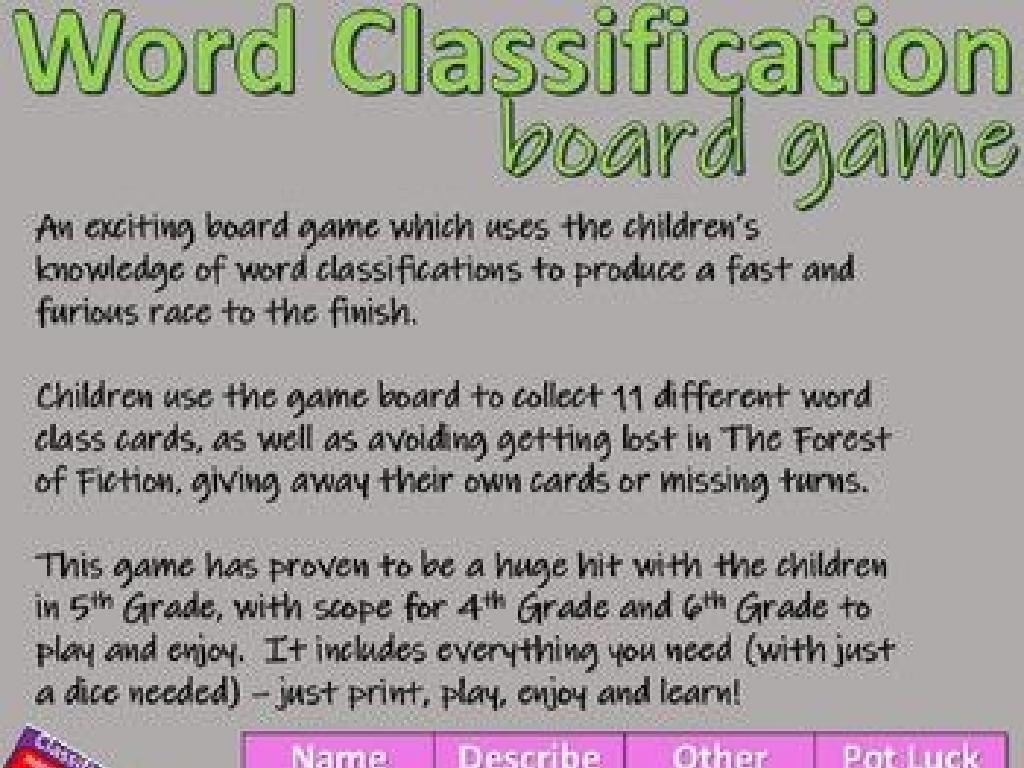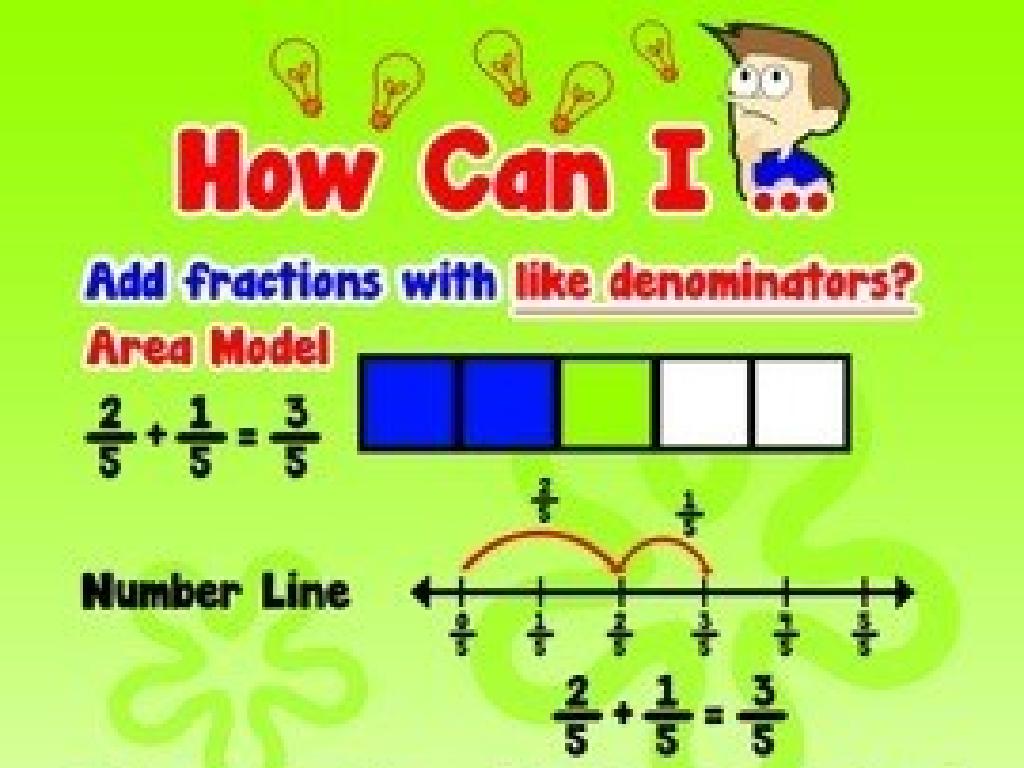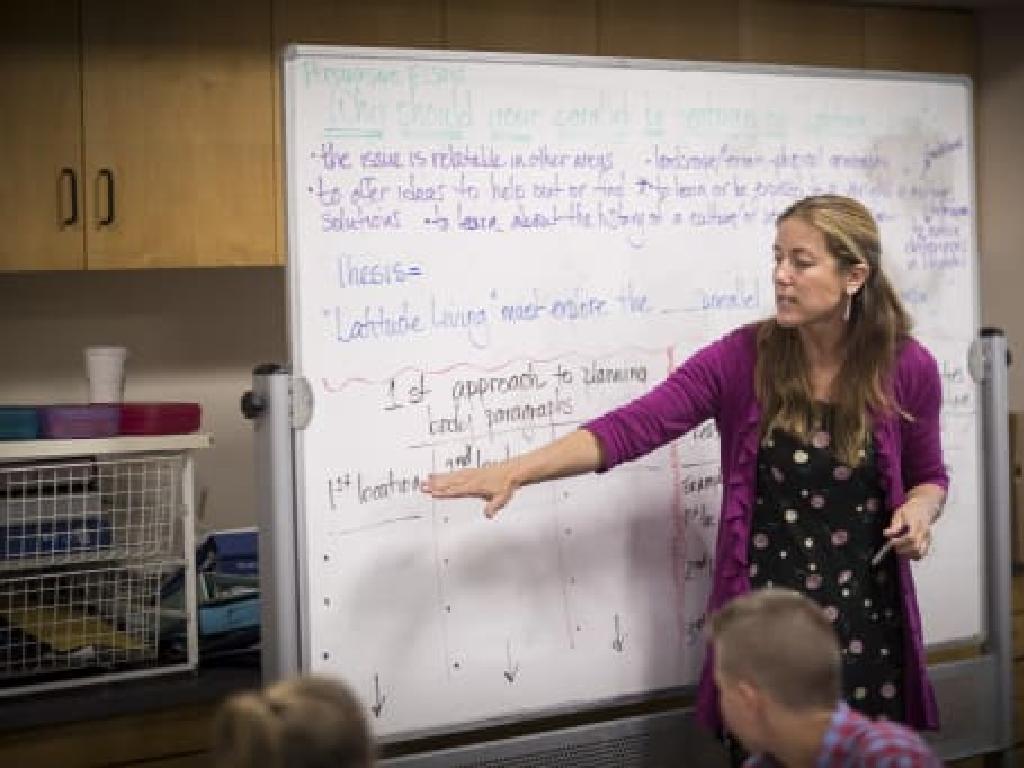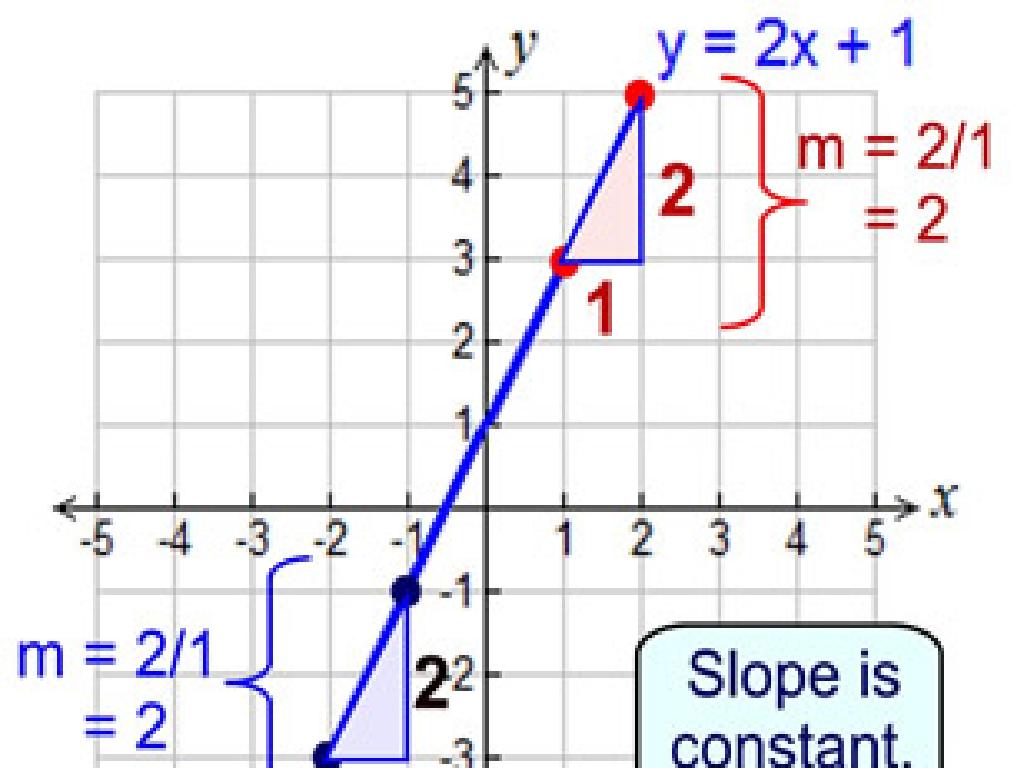Division Facts Up To 10: Find The Missing Number
Subject: Math
Grade: Third grade
Topic: Division Fluency Up To 10
Please LOG IN to download the presentation. Access is available to registered users only.
View More Content
Welcome to Division: Sharing Equally
– What is division?
– Division is splitting into equal parts or groups
– Division facts up to 10
– Learn division tables with numbers 1-10
– Division in daily life
– Use division when sharing snacks or toys with friends
– Practice finding missing numbers
– Solve problems like 20 ÷ ? = 5. What is the missing number?
|
This slide introduces the concept of division to third-grade students as a way of sharing things equally. Start by explaining division as a fair sharing method, which is a relatable concept for children. Emphasize the importance of knowing division facts up to 10, as these are the building blocks for more complex math problems. Illustrate the relevance of division in everyday life with examples such as dividing treats among friends or splitting a set of crayons. Encourage students to engage with the material by providing practice problems where they have to find the missing number in a division equation. This interactive approach helps solidify their understanding and demonstrates the practical use of division.
Understanding Division
– Division is sharing equally
– Imagine splitting cookies evenly with friends
– It shows how many groups we can make
– If we have 10 cookies for 2 friends, how many groups?
– It tells us items per group
– With 10 cookies for 2 friends, how many cookies each?
– Division as fair sharing
|
This slide introduces the concept of division to third-grade students by relating it to the idea of sharing equally among friends. It’s important to use relatable examples, such as dividing cookies, to help students visualize the process. Explain that division can tell us either the number of groups we can form or the number of items each person gets when we divide equally. Use manipulatives like counters or drawings to demonstrate division with small numbers. Encourage students to think of division as a fair way to share things equally and to understand that finding the missing number in a division problem helps ensure that sharing is fair.
Division Vocabulary: Key Terms
– Dividend: Number being divided
– If we have 15 apples and make 3 groups, 15 is our dividend.
– Divisor: Number you divide by
– Divisor is like how many cookie jars we have.
– Quotient: The division result
– Quotient is how many cookies go into each jar.
– Finding missing numbers
– Use ‘inverse operation’ of multiplication to find missing numbers.
|
This slide introduces students to the basic vocabulary of division, which is essential for understanding and solving division problems. The dividend is the total amount that you want to divide up, such as a number of apples. The divisor is the number of groups you are dividing the dividend into, like the number of cookie jars you have. The quotient is the result you get after division, which tells you how many items go into each group or jar. To find a missing number in a division problem, students can use the inverse operation, which is multiplication. For example, if they know the divisor and the quotient, they can multiply them to find the dividend. Encourage students to practice with different numbers to become comfortable with these terms.
Division Facts with Arrays
– Arrays show division clearly
– Total items represent the dividend
– If there are 20 apples in total, that’s our dividend
– Items in one row are the divisor
– If each row has 5 apples, that’s our divisor
– Rows count equals the quotient
– We have 4 rows of apples, so our quotient is 4
|
This slide introduces students to the concept of using arrays to understand division facts. Arrays are a visual representation that can make it easier for third graders to grasp the division process. Start by explaining what an array is and how it can be used to visualize division. Show them how to count the total number of items in the array to find the dividend, then count the number of items in one row to determine the divisor. Finally, count the number of rows to find the quotient. Use concrete examples with actual items, such as apples, to make the concept relatable. Encourage students to draw their own arrays and practice finding the dividend, divisor, and quotient.
Division Facts: Finding the Missing Number
– Use multiplication for division
– Example: 4 x ? = 20, find ?
– If 4 times a number equals 20, that number is the answer to 20 divided by 4.
– Practice with various equations
– Try different numbers to see what fits.
– Solve 20 ÷ 4 = ?
– What number times 4 gives you 20?
|
This slide is aimed at helping students use their multiplication skills to find missing numbers in division problems. Start by explaining that multiplication and division are opposite operations. Show them how knowing that 4 multiplied by 5 equals 20 can help them solve 20 divided by 4. Encourage students to practice with different division equations, reinforcing the concept that division is finding how many times a number is contained within another number. Provide several examples and encourage students to work through them, using multiplication as a tool to find the missing number in a division equation.
Let’s Practice Division Together!
– Pair up for problem-solving
– Use counters or drawings
– Objects help visualize division
– Discuss solutions with your partner
– Talking about methods clarifies thinking
– Share findings with the class
|
This slide is designed to engage students in a collaborative and interactive learning experience. By working in pairs, students can tackle division problems together, which promotes peer learning and problem-solving skills. Encourage them to use physical objects like counters or visual aids like drawings to better understand the concept of division. This tactile approach helps solidify the abstract concept of division into something concrete. After solving the problems, students should discuss their methods and answers with each other to reinforce their understanding. Finally, sharing their findings with the class will allow them to articulate their thought process and demonstrate their knowledge. As a teacher, facilitate the activity by providing guidance and ensuring each pair has the necessary materials. Prepare a few examples of division problems for them to solve and consider having different sets of problems for varied levels of difficulty to cater to all students.
Division Games: Mastering Division Facts
– Play division games electronically
– Challenge with various difficulty levels
– Start easy, then try the harder levels
– Learn division facts through play
– Games make learning division fun
– Enjoy and reinforce math skills
|
This slide introduces an interactive and enjoyable method for students to practice division facts up to 10 by playing educational games on a computer or tablet. Encourage students to start with games at an easy level and gradually move to more challenging levels to test and improve their division skills. Emphasize that learning can be fun and that these games are a great way to reinforce their math skills. For the teacher: Prepare a list of recommended division games suitable for third graders. Ensure that the games are educational and engaging. Monitor the students’ progress and offer help if they encounter difficulties. Consider organizing a division game day where students can share their high scores and what they’ve learned.
Class Activity: Division Bingo
– Receive your Division Bingo card
– Solve division problems on the card
– Use division facts up to 10 to find missing numbers
– Match answers to your Bingo grid
– Each correct answer gets you closer to Bingo!
– Aim for five in a row to win
|
This interactive class activity is designed to help students practice and reinforce their division facts up to 10. Each student will receive a unique Bingo card filled with answers to various division problems. They must solve division problems to find the corresponding answers on their Bingo cards. The first student to align five correct answers vertically, horizontally, or diagonally and shout ‘Bingo!’ will be declared the winner. For the teacher: Prepare the Bingo cards in advance, ensuring a mix of division problems. Monitor the students as they work through the problems to ensure they are using the correct division facts. Have small prizes ready for the winners to make the game exciting. Encourage students to double-check their work before shouting ‘Bingo!’ to practice accuracy alongside speed.
Wrapping Up: Division Facts Mastery
– Congratulations on learning division facts!
– Practice with your homework sheet
– Complete the problems to reinforce today’s lesson
– Get ready for more division fun next class
– We’ll dive deeper into division in our next lesson
– Keep practicing to become a division star!
|
This slide is designed to congratulate the students on their hard work during the lesson and to remind them of the importance of practicing at home to solidify their understanding of division facts up to 10. The homework sheet should contain a variety of problems that require students to find missing numbers in division equations. Encourage students to try their best and assure them that practice is key to becoming confident in division. Let them know that the next class will bring new challenges and learning opportunities in division, aiming to build excitement and curiosity for the upcoming lesson.






